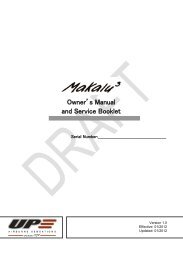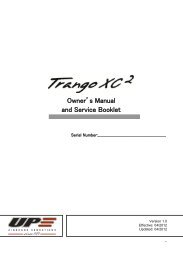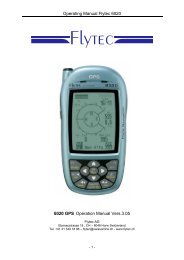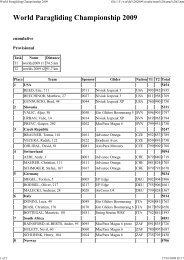Owners Manual and Service booklet - Eagle Paragliding
Owners Manual and Service booklet - Eagle Paragliding
Owners Manual and Service booklet - Eagle Paragliding
- No tags were found...
You also want an ePaper? Increase the reach of your titles
YUMPU automatically turns print PDFs into web optimized ePapers that Google loves.
______________________________________________________________________________brake pressure <strong>and</strong> accelerate rapidlydown the hill. After a few steps you willreach flying speed <strong>and</strong> become airborne.Speed controlUsing the brakesThe UP Ascent 2 has a wide useablespeed range, coupled with excellentstability at all speeds. The speed canbe set with the brakes to optimiseperformance in any situation.Maximum glide speed is achieved with thebrakes released completely, whereasminimum sink speed is with approximately15-20cm of brake applied. Further brakingwill not improve the sink rate, but thebrake pressure increases noticeably asthe glider reaches minimum speed.BEWARE! Flying close to the stallpoint is very dangerous <strong>and</strong>should be avoided. At speedsbelow minimum sink the dangerof entering an unintentional stall orspin is increased dramatically.Using the Speed SystemThe UP Ascent 2 is supplied with a speedsystem, which is activated by a footstirrup. Full application increases thespeed by approximately 11 to 13 km/h. Incertain circumstances the use of thespeed system is extremely effective, <strong>and</strong> itshould be an integral part of your flying.The speed system should be used whenyou are flying through sinking air, whentrying to achieve best glide in a headwind,or trying to cover the ground as quickly aspossible. But it is important to rememberthat the glider will be more susceptible tocollapses at high speeds, so the speedsystem should not be used in extremeturbulence. If, with the speed systemapplied, a collapse occurs then it shouldbe released immediately. Somewarning of an imminent collapse isafforded by the tension felt in thespeed system; should the tensionsuddenly reduce then the stirrupshould be released <strong>and</strong> the gliderreturned to normal trim speed.BEWARE! All extreme flightsituations, such as collapses,happen more dramatically atincreased speed. Thereforethe speed system should notbe operated near the ground or innoticeable turbulence.TurningThe UP Ascent 2 has been developedto meet the dem<strong>and</strong>s of intermediatepilots. The brakes have been designedso that the first 15 to 20 centimeter oftravel will cause a soft <strong>and</strong> directturning, whereas larger movementswill give the glider an agile <strong>and</strong> nimblefeel.Brake input <strong>and</strong> amount of weight shiftinduced will define the radius <strong>and</strong> bankangle on the UP Ascent 2, <strong>and</strong> willallow it to be controlled with ease.Using weight shift in combination withbrake input will result in flat turns withminimum height loss <strong>and</strong> is in factalways the most efficient controlmethod. The radius of the turn is thencontrolled with the brake line whereasthe bank is controlled through weightshift.If needed the UP Ascent 2 will turnvery tight. To do this, apply somebrake input on both sides, then releasethe outside brake whilst applyingfurther brake on the inside – this willreduce turning radius to a minimum.When brake input is increased beyondapproximately 50% on one side, theUP Ascent 2 begins a fast <strong>and</strong> steep24






